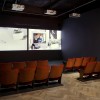The talk of London’s art scene this month is assuredly Frieze. Based on size alone, Jennifer Rubell’s 2013 Portrait of the Artist is amongst the most memorable pieces. Deemed interactive, the gigantic, pregnant nude is over seven metres long. As the title suggests, the sculpture is a representation of the self: the result of a digital body scan of the artist at eight months pregnant. Her belly has been carefully hollowed out, leaving a round cave-like space into which visitors are encouraged to climb. The effect is not as alarming as one may imagine: as I stood and contemplated the work, two children got in and as they wriggled around the roomy womb. The fibre-glass woman appeared more a cosy piece of kitsch furniture than an illustration of an ultrasound.
According to the exhibitor, Rubell aims to change the “power dynamics of viewing by infantilising and minimising the viewer in relation to the artist”. In this sense, the “intimidating gaze of the audience” is mollified, and artist and viewer become one. The piece is a phenomenal gesture of femininity: by inviting the viewer into the womb, the figure offers her maternal protection from the bustle of reality. This year’s exhibitors did not disappoint in stretching the boundaries of expected artistic methods. While there remained an abundance of 2D paintings and photographs, and even some 3D photography, (for example Yeondoo Jung’s Tokyo Story b Camera, Diptych Photography; Kukje Gallery) the obsession with digitalisation was notable. Post-conceptual artist Cory Arcangel shows us a rotating 80 inch Sharp flat screen, on which there is a pixelated photograph of rapper P-Diddy climbing onto his private jet. The other half of the work, Lakes, dominates the last quarter of the screen, where we see a disturbingly realistic moving water effect soak the rapper’s left foot.
iPads were everywhere. We see them crammed into plywood sculptures in Andreas Angelidakis’ work, alongside a mixed-media collection of found objects, sculpture, screens, deer and bird sound effects. Frame’s Andrea Longacre-White’s booth was, in fact, dedicated entirely to Apple creations. The digital was not confined to the frames of screens, with Ian Cheng’s VR headsets allowing the audience to control what they see via the technological responses to their head movements, hybridising their viewing experience.
Contradicting this fast-paced, futuristic ethos was Gabriel Kuri’s tapestry from Mexico’s Kurimanzutto, one of my personal favourites. Turning original digital prints into handmade embroidery, Kuri has paraphrased the receipt- most mundane talismans of consumerist life – by sewing the unidentifiable codes, exotic purchases and the cashiers’ names onto the immense linen hanging. Kuri allows us more than black and white type through addition of striking purple lines that signify the cashier’s nightmare: the end of the till roll. Of course, there was the usual fair share of the controversial, particularly in David Shrigley’s Lady Taking A Poop sculpture, Omer Fast’s four-screened film on the intimate life of porn stars, the penises of Louise Bourgeois and Sarah Lucas’ tan tights formed into breasts, spilling out of a toilet. Whilst these may no longer cause that same degree of ruckus as in previous years, these works show us that use of shock factor in art has not yet run its course.
Distorted mirrors were also a prominent theme, perhaps encompassing Rubell’s desire for the artists to place the viewer in the work, taking the pressure off themselves. Olafur Eliasson’s Fade Door Up threatens to bring on a headache, as when contemplating your feet, your head seems to traverse into a mysterious mist with no obvious source. Other mirrors, like those of Robert and Trix Haussmann of Herald Street Gallery, ask that you hunt down your reflection, found only in the top right-hand corner when you stand a metre away on your tiptoes. Doug Aitken’s You/You from New York’s 303 Gallery leaves you staring at the mirrored words “you”, ironically obscuring the reflection of the viewer.
Represented by Johann Konig and 303 Gallery, Jeppe Hein’s work seems to be nothing but reflective surfaces. Geometric Mirrors takes us on a voyage of self-discovery; as we follow the multiplying reflections of ourselves focus is removed from the artist. Right Diagonal Cut distorts the centred viewer, showing them as five stretched selves.
The fact that this is not a new trend is reflected in my mirror piece of preference, which lay a 5 minute bus shuttle away at Frieze Masters. A 1970s work by Italian artist Michelangelo Pistoletto, Donna Nuda Con Girasola is a mirror with a centred silkscreen depicting a bunch of sunflowers and entering female nude. Imaginations are let to run riot as we ask ourselves: ‘Who am in this piece, the delivering florist, the awaited lover, or a mere passing voyeur?” Pistoletto’s neighbouring piece, Boy With A Dog left me wondering what I’d done to deserve such a barking at. His life- size figures next to us invoke a whole new depth of gaze as we enter into the world we’re now viewing. As the artist says himself, “the dynamic reflection does not create a place…it reflects a place that already exists – the static silhouette only re-proposes a pre-existing place.” Certainly it places pressure on the viewer not to unsettle the composition.
Taking Barthes’ Death of the Author to extremes, this year’s Frieze asserts that we don’t sit and contemplate the artist’s biography in their work. Rather, we find ourselves in it, personally plunging into the ever-evolving kaleidoscopic world of artistic output.













